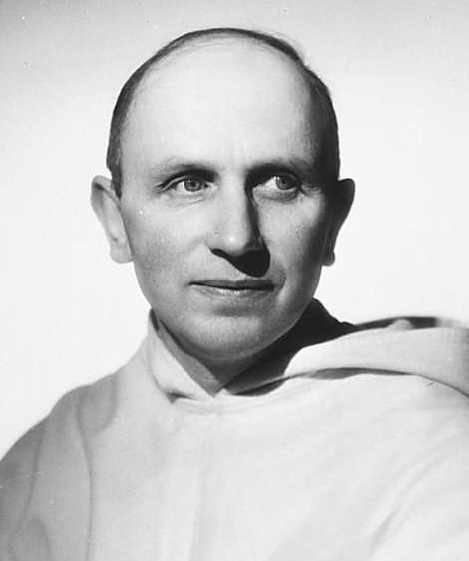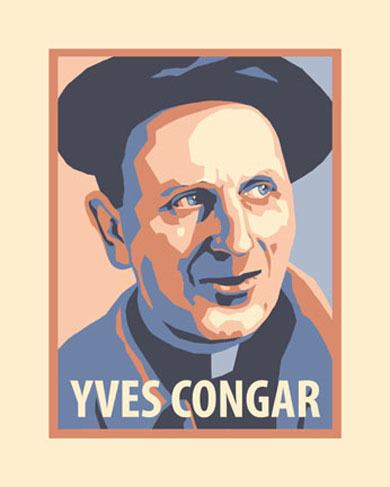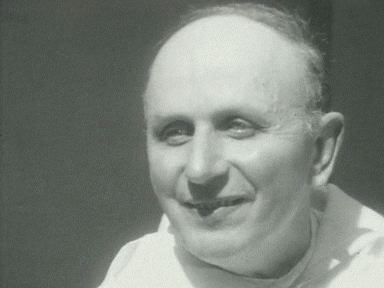Term ended 22 June 1995 Denomination Roman Catholic Appointed November 26, 1994 Nationality French Role Friar | Rank Cardinal Deacon Name Yves Congar Coat of arms | |
 | ||
Born 13 April 1904Sedan, Ardennes, France ( 1904-04-13 ) Education Catholic University of Paris Parents Lucie Congar, Georges Congar Books The Meaning of Tradition, True and False Reform in, Tradition & Traditions: The Biblic, Diversity and communion, Essential Writings Similar People Hans Urs von Balthasar, Hans Kung, Walter Kasper, Mike Aquilina | ||
Created Cardinal 26 November 1994 | ||
Faithful and Free: Yves Congar on the Vocation and Mission of the Laity | October 1, 2010
Yves Marie-Joseph Congar, O.P., (Yves Marie Joseph Congar: 13 April 1904 – 22 June 1995) was a French Dominican friar, Catholic priest, and theologian. He is perhaps best known for his influence at the Second Vatican Council and for reviving theological interest in the Holy Spirit for the life of individuals and of the church. He was made a cardinal of the Catholic Church in 1994.
Contents
- Faithful and Free Yves Congar on the Vocation and Mission of the Laity October 1 2010
- Yves congar et le concile vatican ii
- Early life
- Priest and POW
- Scholar and ecumenist
- Cardinal and death
- Selected works
- Media portrayal
- References

Yves congar et le concile vatican ii
Early life

Congar was born in Sedan in northeast France in 1904. His father Georges Congar was a bank manager. Congar's hometown was occupied by the Germans for much of World War I, and his father was among the men deported by the Germans to Lithuania. Upon the urging of his mother, Lucie Congar née Desoye (called "Tere" by Yves throughout his life), Congar recorded the occupation in an extensive series of illustrated diaries which were later published. They provide a unique historical insight into the war from a child's point of view.

Encouraged by a local priest Daniel Lallement, Congar entered the diocesan seminary. Moving to Paris in 1921, he had Jacques Maritain among his philosophy teachers and the Dominican theologian Reginald Garrigou-Lagrange as a retreat master.
Priest and POW

After a year of compulsory military service (1924-5) which Congar spent in the Rhineland, in 1925 he joined the Dominican Order at Amiens where he took "Marie-Joseph" as his name in religion. Towards the end of his theological studies from 1926-31 at Le Saulchoir, the Dominican theologate which at the time was located in Kain-la-Tombe, Belgium, and focused on historical theology, Congar was ordained a priest on 25 July 1930 by Luigi Maglione, nuncio in Paris. In 1931 Congar defended his doctoral dissertation written at Le Saulchoir, on the unity of the Church.

Congar was a faculty member at Le Saulchoir from 1931-1939, moving with the Institution in 1937 from Kain-la-Tombe to Étiolles near Paris. In 1932 he began his teaching career as Professor of Fundamental Theology, conducting a course on ecclesiology. Congar was influenced by the Dominicans Ambroise Gardeil and Marie-Dominique Chenu, by the writings of Johann Adam Möhler, and by his ecumenical contacts with Protestant and Eastern Orthodox theologians. Congar concluded that the mission of the church was impeded by what he and Chenu termed “Baroque theology."
In 1937 Congar founded the Unam Sanctam series, addressing historical themes in Catholic ecclesiology. These books called for a “return to the sources” to set theological foundations for ecumenism, and the series would eventually run to 77 volumes. He wrote for a wide variety of scholarly and popular journals, and published numerous books.
During World War II Congar was drafted into the French army as a chaplain with the rank of Lieutenant. He was captured and held from 1940 to 1945 as a prisoner of war by the Germans in Colditz and Lübeck's Oflag, after repeated attempts to escape. Later he was made a Knight (Chevalier) of the French Legion of Honour, and awarded the Croix de Guerre. In addition he was awarded the Médaille des Évadés for his numerous escape attempts.
Scholar and ecumenist
After the war, Congar continued to teach at Le Saulchoir, which had been returned to France, and to write, eventually becoming one of the most influential theologians of the 20th century on the topic of the Roman Catholic Church and ecumenism.
Congar was an early advocate of the ecumenical movement, encouraging openness to ideas stemming from the Eastern Orthodox Church and Protestant Christianity. He promoted the concept of a "collegial" papacy and criticised the Roman Curia, ultramontanism, and the clerical pomp that he observed at the Vatican. He also promoted the role of lay people in the church. Congar worked closely with the founder of the Young Christian Workers, Joseph Cardijn, for decades.
From 1947 to 1956 Congar’s controversial writing was restricted by the Vatican. One of his most important books True and False Reform in the Church (1950) and all of its translations were forbidden by Rome in 1952. Congar was prevented from teaching or publishing after 1954, during the pontificate of Pope Pius XII, following publication of an article in support of the ‘worker-priest’ movement in France. He was subsequently assigned to minor posts in Jerusalem, Rome, Cambridge and Strasbourg. Eventually, in 1956, Archbishop Jean Julien Weber of Strasbourg assisted Congar in returning to France.
Congar's reputation recovered in 1960 when Pope John XXIII invited him to serve on the preparatory theological commission of the Second Vatican Council. Although Congar had little influence on the preparatory schemas, as the council progressed his expertise was recognized and some would regard him as the single most formative influence on Vatican II. He was a member of several committees that drafted conciliar texts, an experience that he documented in great detail in his daily journal. The journal extended from mid-1960 to December 1965. Following his direction, his journal was not released until 2000, and was first published in 2002 as Journal d’un theologien 1946–1956 and My Journal of the Council, with English translation in 2012.
After the council, Congar said “respecting many questions, the council remained incomplete. It began a work which is not finished, whether it is a matter of collegiality, of the role of the laity, of missions and even of ecumenism.” Congar's work focused increasingly on the theology of the Holy Spirit, and his 3-volume work on the Spirit has become a classic. He was also a member of the International Theological Commission from 1969 to 1985.
Congar continued to lecture and write, publishing work on wide ranging topics including Mary, the Eucharist, lay ministry and the Holy Spirit, as well as his diaries. His works include The Meaning of Tradition and After Nine Hundred Years which addresses the East-West Schism.
In 1963, Congar was diagnosed with a "diffuse disease of the nervous system" which caused weakness and numbness in his extremities. In 1985, the diagnosis was changed to a form of sclerosis which increasingly affected his mobility and writing ability, and made his scholarly research difficult. He became a resident at the Military Hôpital des Invalides in Paris from 1986.
Cardinal and death
In November 1994 he was named a cardinal deacon by Pope John Paul II, shortly before his death on 22 June the following year. His remains were buried in Montparnasse Cemetery.
